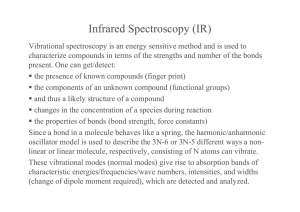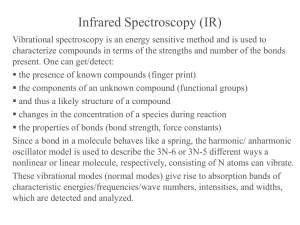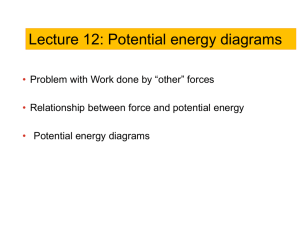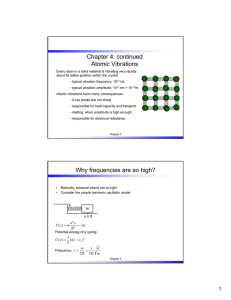F =-k(r-req) - ResearchGate
advertisement
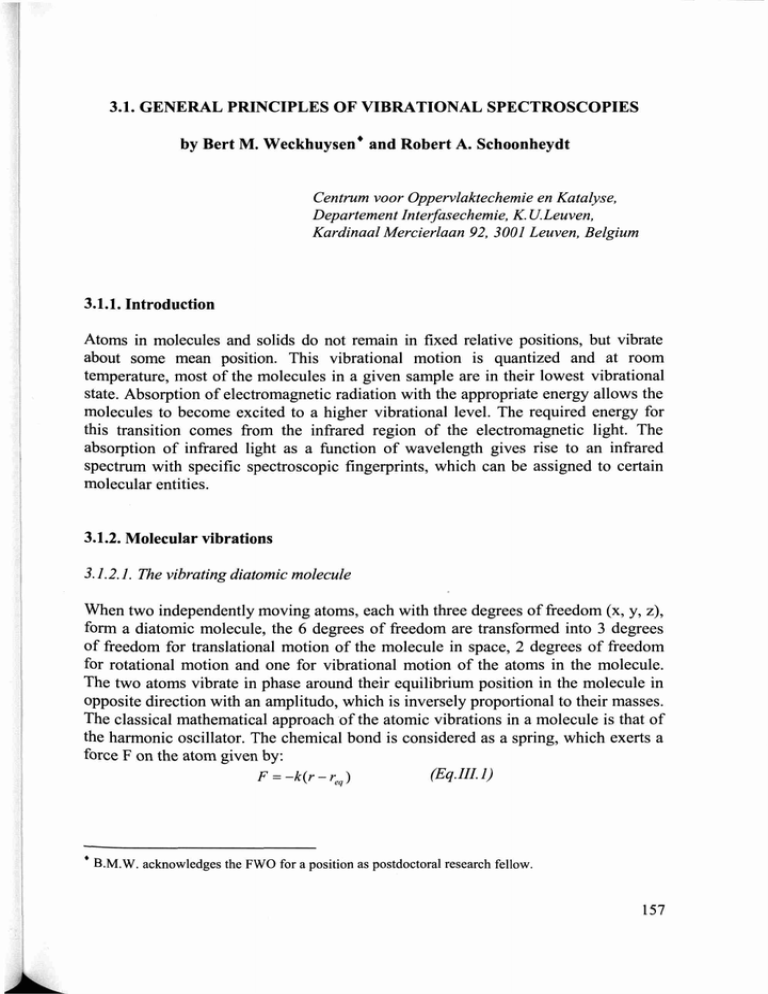
3.1. GENERAL PRINCIPLES OF VIBRATIONAL SPECTROSCOPIES by Bert M. Weckhuysen' and Robert A. Schoonheydt Centrum voor Oppervlaktechemie en Katalyse, Departement Interfasechemie, K. U.Leuven, Kardinaal Mercierlaan 92, 3001 Leuven, Belgium 3.1.1. Introduction Atoms in molecules and solids do not remain in fixed relative positions, but vibrate about some mean position. This vibrational motion is quantized and at room temperature, most of the molecules in a given sample are in their lowest vibrational state. Absorption of electromagnetic radiation with the appropriate energy allows the molecules to become excited to a higher vibrational level. The required energy for this transition comes from the infrared region of the electromagnetic light. The absorption of infrared light as a function of wavelength gives rise to an infrared spectrum with specific spectroscopic fingerprints, which can be assigned to certain molecular entities. 3.1.2. Molecular vibrations 3.1.2.1. The vibrating diatomic molecule When two independently moving atoms, each with three degrees of freedom (x, y, z), form a diatomic molecule, the 6 degrees of freedom are transformed into 3 degrees of freedom for translational motion of the molecule in space, 2 degrees of freedom for rotational motion and one for vibrational motion of the atoms in the molecule. The two atoms vibrate in phase around their equilibrium position in the molecule in opposite direction with an amplitudo, which is inversely proportional to their masses. The classical mathematical approach of the atomic vibrations in a molecule is that of the harmonic oscillator. The chemical bond is considered as a spring, which exerts a force F on the atom given by: (Eq.IIL1) F =-k(r-req) B.M.W. acknowledges the FWO for a position as postdoctoral research fellow. 157 where k is the force constant in N.m'I and req ,the equilibrium bond distance in m. The minus sign indicates that the force is opposite to the direction of movement of the atom. This is schematically illustrated in Figure 111. 1. Figure III.1 Schematic representation of the chemical bond considered as a spring, which exerts a force F on an atom. req Internuclear distance r Figure IIL2. The parabolic curve of energy plotted against the extension or compression of a harmonic oscillator obeying Hooke's law. The allowed vibrational energy levels and the transitions between them are also included. The resulting vibrational energy is: Ev;b = I 2 k(r - re Q )z (Eq.II1.2) k (Eq.III.3) and the frequency: Covib = 27Uv;b ,u with ,u = reduced mass = mi m2 ml +m2 Thus, the harmonic vibration of a diatomic molecule can be viewed as the vibration of a spring with mass equal to the reduced mass of the molecule and force constant k. The latter is a measure of the chemical bond. In Eq.III.3, co is in s_1 or Hz. In 158 vibrational spectroscopy, one uses wavenumbers instead of frequencies. Making use of the fundamental relation, c = vA , with A = wavelength in m and c = light velocity in vacuo = 2.99 x 108m.s I one obtains: v(m ') _ 2c (Eq.III.4) p The unit m-1 is obtained if c is in m.s-', k= N.m 1 and µ in kg. To obtain cm -1 one has to divide by the factor 100. From Eq. 111.4, one can conclude that the vibrational frequency of a chemical bond is related to the masses of the vibrating atoms and the force constant. The larger the force constant, the higher the vibration frequency. On the other hand, vibration frequencies relate inversely to the masses of the vibrating atoms: a light atom oscillates faster than a heavy one. This is illustrated in Table 111. 1 for the molecule CO with different isotopic combinations. Table X. I Vibration frequency of CO with different isotopic combinations. Molecule v (cm 1) 12-16 CO C O 12-18 CO 2143 13 13 C 2096 2091 2041 180 In quantum mechanics the harmonic vibration of a diatomic molecule is treated by solving the corresponding time-independent Schrodinger equation: -hz -Ii d yr(r2 req)+2k(r-r (Eq.III.5) eq)2yl(r-req)=Eyr(r-req) 2p dr 2 The solution, which can be found in standard textbooks of physical chemistry or spectroscopy [1,2] is that the vibrational energy in quantized according to: (Eq.IIL 6) E = h u, (n + 1) with n = 0, 1, 2,... 2 2 n is the vibrational quantum number and v the frequency of the harmonic oscillator as given by Eq.1II.3. These vibrational levels are indicated in Figure 111.2. At any temperature T, the molecular vibrations are distributed over the energy levels according to Boltzmann's law: In + N = NT.exp )h vvib 2 I (Eq. IIL 7) kT At room temperature, only the level n = 0 is occupied. Thus, when the molecules interact with light of frequency U,,;b , they absorb the photon and are excited to the level n = 1. 159 ho,,, =AE=E,-E. =(I+1)huvi. Ihuwb b 2 (Eq.1118) 2 Eo=1 h t)vib is also called the zero point energy, because all the molecules occupy 2 that level at -273°C. t Energy Harmonic oscillator Anharmonic oscillator -0. Intemuclear req distance r Figure 111.3. The energy of a diatomic molecule undergoing anharmonic extensions and compressions. It is shown in Figure 111.3 that the real potential energy curve deviates from that of the harmonic oscillator (Eq. III2). For r < req this is due to electronic repulsion; for r > req it can be ascribed to electronic rearrangements as the atoms move further and further apart. This difference between the potential energy curves of the harmonic oscillator and of a diatomic molecule is called anharmonicity. This anharmonicity can be treated in classical mechanics with adapted versions of the potential energy curve. One can also expand the potential energy as: V(r eQ)=Vo+ av ) a (r - e9) av I 2 (r ea)+ a(r - 2! eq r) 2 travl 3 Z (r- er/) +11 n/.. ._ 13 (r - eq)3+... (Eq.I11. 9) av Putting Vo = 0 and knowing that 1 a(r - r ) r-rN , one obtains the harmonic oscillator if only the second derivative is retained: V(r - rq) = 160 1 a zV 2! a(r - r ) 2 eq (r-req)2 ry (Eq.II1.10) I Comparison of Eq.1II.2 with Eq.1II.10 shows that: k= a2v La(r - r,,)' (Eq.III. 11) The simplest treatment of anharmonic oscillators is to include the third derivative in the potential energy expression. The corresponding quantum mechanical expression of the energy is: E =(n+1)hv,,.b-(n+i )2xohvv;b (Eq.III. 12) xa is called the anharmonicity constant, which is always small but positive; and Uv;b the frequency of the harmonic vibration. The transition n = 0 to n = 1 is obtained by absorption of a photon with frequency UQ such that: h va = E, - E0 = (1- 2xa )h Vvib (Eq.III.13) One observes that the vibrational frequency of the anharmonic oscillator U a is lower than that of the harmonic vibration UV;b . This can be seen by comparing Figures 111.2 and 111.4. The difference between the energy levels of the harmonic and anharmonic vibrations increases with quantum number n. The second consequence of anharmonicity is that besides An = ±i, also higher order transitions are allowed An = ±2,±3... and visible in the spectra. These bonds are called overtones and are usually much less intense than the fundamental ones An = ±1 . Energy 1 Figure 111. 4. The allowed vibrational energy levels and some transitions between them for a diatomic molecule undergoing anharmonic oscillations. To take again our example CO, x,, is equal to 0.0061. This results in a vibration at a lower frequency (2143 cm-') in comparison with that of the ideal harmonic oscillator approach (2169 cm 1). The first overtone for CO is at 4259 cmI. 161 3.1.2.2. The vibrations of polyatomic molecules. When N independently moving atoms are combined in a molecule, the 3N degrees of freedom are transformed into 3 degrees of translational freedom, three for rotation (two for linear molecules, because the molecular axis is not a rotational axis) and 3N-6 (3N-5) for vibrations. In the harmonic approximation the potential energy curve of Eq. 111.9 is written as: I N-6 a2V V = -11 a( Y - eq )a(rj j.; ; - eg ) (r. - req)(rj - re , ) (Eq.I7L 14) " .r, With this expression Newton's equation of motion cannot be solved. The physical reason is illustrated in Figure 111.5 for a molecule with 5 atoms. An atom in the molecule cannot vibrate independently of the other 4. When E vibrates, it will affect B and this in turn affects the 3 other atoms. Figure 111. 5. A hypothetical molecule with 5 atoms. One has to perform an orthogonal transformation of the co-ordinates of the atoms into normal coordinates to obtain the 3N-6 (3N-5) independent fundamental vibrations of the molecule. Such a normal coordinate is of the form Q, Qi 3N-6 = I Aj (r. - r9) (Eq. I11.15) j=1 and the potential energy expression Eq.III.14 becomes: V _I J = 2 C v1 aQ 2 2 Q oQ; (Eq.III.16) The harmonic vibration of every normal coordinate can now be treated independently of all the other normal coordinates. The result for every normal coordinate is exactly the same as for the harmonic oscillation of a diatomic molecule both in Newton's mechanics and in quantum mechanics. Thus for every normal coordinate one has: E;=(n+I)hv, 2 162 (Eq.11I.17) where i runs over the 3N-6 normal coordinates. Physically, in a fundamental harmonic vibration of a normal coordinate all the atoms vibrate in phase with the same frequency. In practice, groups of atoms in a molecule, such as functional groups in organic molecules, vibrate - to a first approximation - independently of the rest of the molecule. They give rise to the so-called group frequencies. These group frequencies are tabulated and form the basis of the interpretation of any vibrational spectrum [2]. The 3N-6 (3N-5) fundamental vibrations can also be subdivided according to the type of movement of the atoms in the molecule. If the vibration is a bond lengthening/shortening, such as for the diatomic molecule (Figure 1I1.1), one has a stretching vibration, designated by the symbol v. One adds the subscripts a and s to indicate respectively antisymmetric and symmetric stretching. In the last case the lengthening/shortening of the bonds occurs in phase; in the first case out of phase. This is illustrated for water in Figure 111.6. t W ® US 0W Ua Figure 111. 6. Symmetric and antisymmetric vibrations of water. The number of stretching vibrations is equal to the number of bonds; i.e., N-1, except for rings. The remaining 2N-5 vibrations given a change in bond angles and do not affect bond lengths. They are called bending vibrations. It is much more easily to change a bond angle than a bond length. In vibrational terms: the force constant of a stretching vibration is larger than that of a bending vibrations or the frequencies of stretching vibrations of a group are always higher than those of the bending vibrations. Summarizing, there are then several criteria for bond assignment in vibrational spectroscopy 1. Tables of group frequencies 2. Strength of the bonds 3. Stretching versus bending vibrations 4. Mass of the atoms Because there are more than 2 atoms vibrating in a normal coordinate there is no simple relation between the vibrational frequency and force constant or mass of the atoms. But the general rules of the diatomic molecule remain qualitatively valid: 1) Frequency 71 if the mass of the atoms l 2) Frequency 71 if the bond strength 71 163 Finally, the number of vibrations increases rapidly with the number of atoms. Thus while one has 3 normal vibrations in water, this is 30 for benzene. Experimentally one does not observe all 30 vibrations for two reasons: (a) Normal vibrations may have the same frequency; they are degenerate (b) Some vibrations are forbidden according to Laporte's selection rule. Here, symmetry and group theory play an important role. In general, vibrations which induce a change in dipole moment are allowed in infrared spectroscopy; vibrations which induce a change in polarisability of the molecule are allowed in Raman spectroscopy. The reader has to consult the specialized literature to obtain the details of these statements [1,2]. 3.1.3. References [1] C.N. Banwell, Fundamentals of Molecular Specrtroscopy, 3`d Ed. McGraw-Hill Book Company, London, 1983. [2] K. Nakamoto, Infrared and Raman Spectra of Inorganic and Coordination Compounds, 5'h Ed., John Wiley & Sons, Inc., New York, 1997. 164
